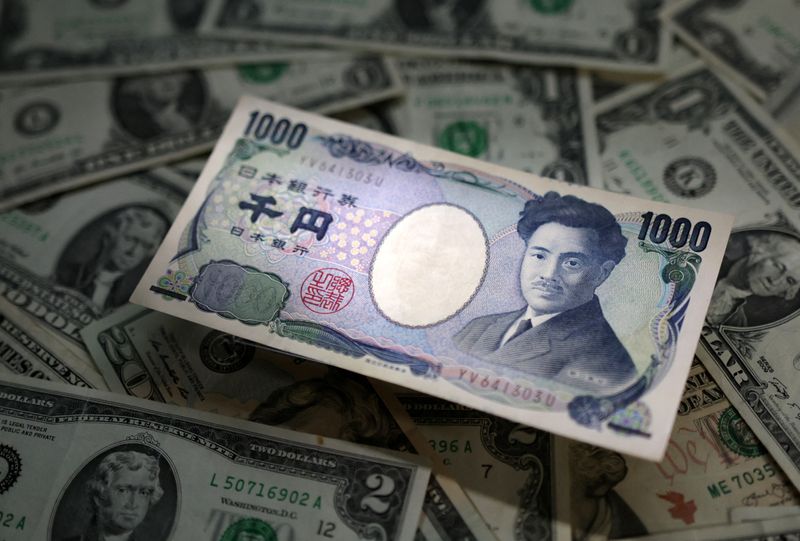By Herbert Lash
NEW YORK (Reuters) -The dollar strengthened on Monday after a survey from the Federal Reserve showed U.S. banks reported tighter credit standards and weaker loan demand during the second quarter, a sign rising interest rates are having an impact on the economy.
The Fed's quarterly Senior Loan Officer Opinion Survey, or SLOOS, which is directed both at businesses and consumers, also showed that banks expect to further tighten standards over the rest of 2023.
"Of course, in a higher interest rate environment you'd expect to see a tightening of lending standards and also a softening of demand," said Marc Chandler, chief market strategist at Bannockburn Global Forex in New York.
{{2126|The dodollar index, a measure of the greenback against six major currencies, rose 0.28% after trading little changed earlier in the session.
The U.S. unemployment report for June on Friday will likely be strong while next week's Consumer Price Index (CPI), also for June, may show the pace of inflation increasing for the first time from a year ago, Chandler said.
"Some people think it's the tip of the iceberg. Gasoline prices are rising," he said.
Friday's non-farm payrolls will be the first of several data points that will shape a Fed interest rate decision in late September. Before then, central bank leaders will attend the Fed's Aug. 24-26 symposium in Jackson Hole, Wyoming, where structural shifts in the global economy will be in focus.
"We'll have to see if the data from the U.S. continues to paint a resilient picture of the U.S. economy, and if it does, that can help the dollar at least tread water between now and Jackson Hole," said Joe Manimbo, senior market analyst at Convera in Washington.
The euro retreated from early gains after data showed economic growth in Europe nudged higher and inflation ticked lower. The euro fell 0.2% to $1.0993.
The yen extended losses after the Bank of Japan (BoJ) last week loosened its grip on interest rates, but the currency posted its first monthly gain against the dollar since March.
The dollar advanced 0.78% against the yen at 142.250 after a fresh intervention by the BoJ on Monday.
The yen went into a tailspin on Friday as traders tried to determine the implications of the BoJ's move to maintain ultra-low rates while making its bond yield curve control (YCC) policy more flexible and loosening its defense of a long-term rate cap.
The BoJ's policy of keeping yields pinned down has weighed heavily on the Japanese currency for the past year, and fresh intervention on Monday showed it could continue to do so.
Japan's benchmark 10-year government bond yield surged to a nine-year high, spurring the central bank to conduct additional purchase operations to slow its rise.
Elsewhere in Asia, data showed China's manufacturing activity fell for a fourth straight month in July, though the China-exposed Australian dollar and Chinese shares were buoyed by news of further measures to spur the country's sputtering economic recovery.
The Aussie rose 1.05% at $0.6717, and the offshore yuan slipped 0.08% at 7.1433 per dollar, drawing some support from an announcement from China's State Council on Monday on measures to restore and expand consumption in the automobile, real estate and services sector.
The dollar posted its first monthly loss against the yen since March, and its second successive monthly loss against the euro and pound. A key driver of the dollar's strength may have come to an end with last week's 25-basis-point hike.
Data on Friday showed that the annual U.S. inflation rate rose in June at its slowest pace in more than two years, with underlying price pressure receding, easing pressure on the Federal Open Market Committee (FOMC) to continue raising rates.
The euro earlier rose after data showed euro zone inflation fell further in July, while the bloc returned to growth in the second quarter of 2023 with a greater-than-expected expansion.
The euro is eyeing a monthly gain of about 1%. Last week's European Central Bank policy meeting raised the possibility of a rate pause in September, though Rabobank analysts said Monday's data "allow the ECB to both argue for a longer hold as well as for another hike".
Sterling fell 0.13% at $1.2833, but notched a 1.0% monthly gain, ahead of the Bank of England's (BoE) policy meeting on Thursday. Markets are evenly divided between a 25- and 50-basis-point increase.
========================================================
Currency bid prices at 4:07 p.m. (2007 GMT)
Description RIC Last U.S. Close Pct Change YTD Pct High Bid Low Bid
Previous Change
Session
Dollar index 101.8700 101.6100 +0.28% -1.565% +101.9000 +101.5200
Euro/Dollar $1.0995 $1.1015 -0.19% +2.60% +$1.1046 +$1.0994
Dollar/Yen 142.2400 141.1800 +0.75% +8.49% +142.6700 +140.6900
Euro/Yen 156.38 155.48 +0.58% +11.46% +157.2800 +155.1200
Dollar/Swiss 0.8719 0.8709 +0.13% -5.69% +0.8729 +0.8663
Sterling/Dollar $1.2833 $1.2849 -0.12% +6.12% +$1.2872 +$1.2829
Dollar/Canadian 1.3188 1.3252 -0.46% -2.65% +1.3261 +1.3152
Aussie/Dollar $0.6717 $0.6648 +1.05% -1.46% +$0.6739 +$0.6650
Euro/Swiss 0.9584 0.9589 -0.05% -3.14% +0.9623 +0.9556
Euro/Sterling 0.8565 0.8574 -0.10% -3.15% +0.8590 +0.8557
NZ $0.6210 $0.6153 +0.95% -2.18% +$0.6226 +$0.6156
Dollar/Dollar
Dollar/Norway 10.1280 10.2020 -1.05% +2.86% +10.2130 +10.0950
Euro/Norway 11.1402 11.2262 -0.77% +6.16% +11.2520 +11.1264

Dollar/Sweden 10.5254 10.5402 -0.39% +1.12% +10.5595 +10.4666
Euro/Sweden 11.5728 11.6180 -0.39% +3.80% +11.6255 +11.5525